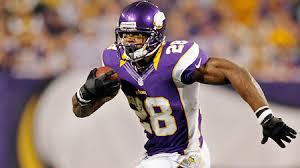Every day, millions of children are corporally disciplined as punishment for some type of misdeed. More so, everyday, many of these same children are physically abused, their chastising quickly escalating into an assaultive beating.
Recently, Minnesota Vikings running back Adrian Peterson came under fire for the revelation of his discipline methods against his children. Photographs of his four-year-old’s legs revealing long, open wounds sustained after being whipped repeatedly with a switch sparked the outrage of many across the country who deemed Peterson’s actions the equivalent of child abuse.
Does Peterson deserve the public’s denunciation? Should he be indicted on child abuse charges?
In order to answer that question, a distinction between acceptable disciplinary methods and child abuse must be made.
There’s no question that failure to discipline a child when warranted by wrongdoing sends an undesired message. However, there’s also no question that abusing a child is wrong and an improper method of discipline. So how do we find balance between the two?
Disciplining children has been a longstanding parenting method since the dawn of time. Not only is it an established tradition, it is an imperative and appropriate one. By punishing toddlers and adolescents when they do something they know to be wrong, parents instill in them a fear for the consequences of their misdeeds, therefore effectively teaching them to respect authority and persuading them to abstain from committing reprehensible acts in the future. The simple fact is without disciplinary measures, our children would grow up to be profane criminals who can’t conceptually visualize the difference between right and wrong.
However, disciplining children is only appropriate when it is performed in the correct manner. The ideal corporal punishment lets the child know that he did wrong and provides incentive for the child to refrain from misbehaving without using excessive force. In my opinion, spanking qualifies as the only proper corporal method of disciplining a child when the parent adheres to specific parameters. Spanking should only be reserved for occasional instances of serious disobedience, which would warrant at most three to five spanks with an open hand, done reasonably light so as not to cause injury. The goal is not to make them cry or cause great physical pain but to dissuade them from misconduct.
The problems with physically, as opposed to verbally, disciplining a child, though, are that most parents fail to recognize their own strength, the fragility and vulnerability of their child, and their child’s low pain threshold. Unaware of the child’s physical limitations and unable to feel the blows that are dealt, parents find difficulty in deciding how much is enough. For this reason, it is easy for parents, especially professional male athletes like Peterson, to get carried away when teaching their child a lesson. Anger boils over, one hard blow turns into ten harder ones, an object such as a belt or a switch in Peterson’s case replaces a hand, and a child is left crying, battered and bruised, and afraid of you.
Personally, I think any excess force used in discipline, whether it be in the form of blunt or sharp objects implemented in the punishment (which should NEVER be used) or of exorbitantly forceful beatings or usage of the hands, qualifies as child abuse. These children, still formulating their moral compasses and still ignorant of proper behavioral etiquette, are defenseless to these types of punishment and should never have to experience such a severe castigation for a usually trivial miscue. Any form of discipline that leaves any kind of long-lasting or permanent mark on the child—a bruise, a scar, a bloody wound, a broken bone— is child abuse. Parents, while given the legal right to discipline their children, shouldn’t be able to abuse them under this guise any longer.
While purposely injuring a child may solve the problem of disobedience, it does not reinforce the loving, forgiving relationship that parents should strive to always maintain with their kids, even in discipline. A malevolent desire to cause retributive injury to the child should never be the central motivation.
Now, let’s apply these standards for discipline to Peterson’s situation. It is safe to say that many African Americans or Southerners received similar or worse abuse to the kind that Peterson inflicted on his son. That is just an inherent part of their culture, a method of discipline that they grew up with and adopted from their parents and grandparents before them. Peterson has stated that he “did not intend to cause [his son] any injury,” and I believe him, as in his mind he simply used the disciplinary method under which he was punished as a child.
But that doesn’t mean he is not at fault and did not abuse his son. The evidence doesn’t lie; Peterson clearly used a disproportionate amount of force on his son by lashing him an unreasonable amount of times with a switch. This discipline gave ugly cuts and bruises to the child, and Peterson must be held accountable for the injury that he caused.
As of right now, Adrian is currently barred from participating in any of the Vikings’ team activities, having been suspended and placed on the NFL’s exempt list. He is also facing a protective court order that would prevent him from having any unsupervised interaction with his son. His season and his future with the organization seem to be in jeopardy as a result of this unfortunate situation.
Are these punishments severe enough? For the time being, yes, I think they are. Ultimately, I do not foresee him serving any jail time for this crime, although a conviction is not entirely out of the picture. And while many think Peterson will not return to the Vikings or the NFL, in a similar fashion to the Ray Rice ordeal, I believe that once his legal case is resolved, Peterson will be given a second chance to change his disciplinary methods and regain the public’s trust.
But for now, holding Peterson out of the league is the right move. Peterson’s play this season would essentially be condoning acts of child abuse, which is obviously not what the NFL is aiming for, as they stand firmly against acts of domestic violence. Until he can get his act together and recuperate for the damage he has caused, he should not be allowed re-entry into the league.
NFL players must recognize that, as popular celebrities, their actions are always under the microscope of the public eye, and that anytime it is revealed that they broke the law, they will have to endure the public’s intense judgment and criticism. They are not exempt from the law and must restore their image by acting accordingly. Child abuse is a serious matter that is not taken lightly by the majority of the population, and Peterson’s story should not be expected to die down any time soon.
Peterson will pay a heavy price for his actions, and hopefully this public outcry against extreme cases of discipline will help to spread awareness and prevent future acts of child abuse all throughout the country.






